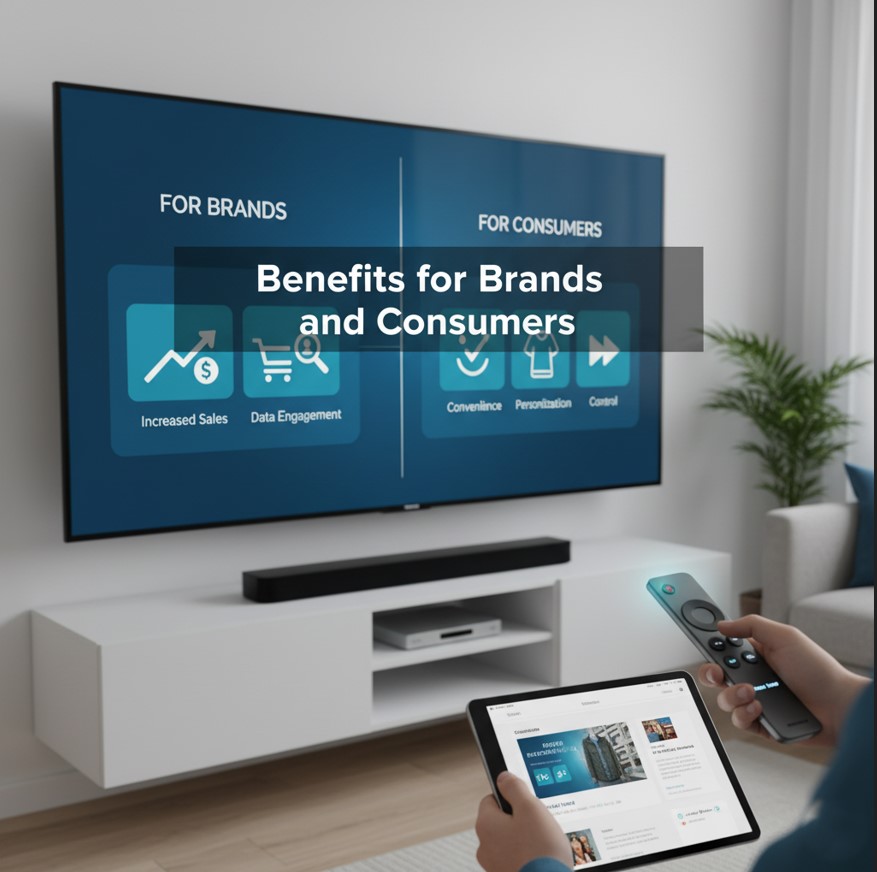In the rapidly evolving world of television advertising, brands are constantly seeking fresh methods to capture viewer attention and drive conversions. Traditional TV ads offer broad reach, but they lack immediacy and measurable engagement. Enter interactive and shoppable TV advertising—a dynamic fusion of television’s mass appeal with digital-era interactivity. This approach empowers viewers to engage with on-screen content in real time and even make purchases directly from their television sets. In this comprehensive guide, we explore how these innovations work, the benefits they deliver, strategies for implementation, real-world case studies, challenges to consider, and future trends shaping the TV advertising landscape.
What Is Interactive & Shoppable TV Advertising?
Interactive TV advertising enables viewers to engage with commercials using their remote controls, smartphones, or connected devices. Instead of passively watching a 30-second spot, audiences can access additional product information, view alternate storylines, or participate in polls and quizzes. Shoppable TV ads take this concept further by integrating e-commerce capabilities directly into the broadcast. Viewers can select an on-screen prompt—such as “Buy Now” or “Learn More”—and complete transactions without leaving their living rooms.

How Interactive TV Ads Work
Addressable and Personalized Ads
Addressable TV advertising uses data on household demographics, viewing habits, and purchase history to deliver personalized ad experiences. Instead of airing a single version of a commercial to every household, advertisers can serve unique variations tailored to specific audience segments—for instance, showing sports equipment to fitness enthusiasts and beauty products to fashion-savvy viewers.
Trigger Points & Interactivity
Interactive ads contain embedded triggers that prompt viewers to take action. These triggers can appear as overlays, QR codes, or interactive hotspots. When a viewer clicks a hotspot—using a smart remote or mobile app—a pop-up appears with extended content, such as product demos, behind-the-scenes footage, or special offers.
E-Commerce Integration
Shoppable TV ads connect to secure payment gateways and retailers’ e-commerce platforms. Viewers can add items to a virtual cart, apply discount codes, and complete purchases using stored payment credentials. Some systems even offer voice-controlled transactions via smart speakers or AI assistants, streamlining the checkout process further.
Benefits for Brands and Consumers

Enhanced Engagement
Interactive elements transform passive viewers into active participants. Polls, quizzes, and clickable hotspots extend dwell time and foster deeper emotional connections. A study by Nielsen found that interactive ads can increase brand recall by up to 30% compared to traditional spots.
Improved ROI and Measurement
Unlike conventional TV metrics, which estimate impressions based on audience ratings, shoppable ads provide precise engagement data and conversion rates. Brands can track click-through rates, average order values, and sales attribution down to the individual household. This granular insight enables continual optimization of creative, offers, and placements.

Seamless Shopping Experience
By eliminating the friction of switching devices or recalling URLs, shoppable TV ads capitalize on impulse buying. When viewers see a product they like, they can act immediately. This convenience boosts purchase intent and reduces abandoned carts, translating to higher sales and customer satisfaction.
Implementation Strategies
Partnering with Technology Providers
Successful interactive campaigns rely on robust back-end systems. Collaborate with TV networks, streaming platforms, or ad tech vendors that support addressable and shoppable ad units. Evaluate their integration capabilities with your CRM, e-commerce, and data-management platforms to ensure seamless execution.
Crafting Interactive Content
Not all ads benefit from interactivity. Identify elements of your creative that invite exploration—exclusive behind-the-scenes clips, product customization tools, live polls, or limited-time offers. Keep interactions intuitive and optional; viewers should never feel forced into clicking.
Data Collection and Privacy
Addressable advertising depends on consumer data. Adhere strictly to privacy regulations such as GDPR, CCPA, and local broadcast guidelines. Provide clear opt-in and opt-out mechanisms, and be transparent about how data is collected, stored, and used to personalize ads.
Case Studies
Retail Brand—Seasonal Promotion
In Q4 2023, a leading sports apparel retailer launched an interactive holiday campaign. During live broadcasts of football games, viewers could press the interactive button on their remotes to browse limited-edition jerseys, view player stats, and access time-sensitive discounts. The campaign achieved a 15% click-through rate and a 25% lift in online sales during primetime slots.
Consumer Goods—Product Launch
A major consumer electronics manufacturer used shoppable TV ads to debut its latest smart speaker. The commercial featured a live-demo mode: viewers could speak voice commands through their remote to trigger product testing segments. Direct purchases from the ad accounted for 18% of the first-week sales, outperforming traditional banner redirects.
Automotive Industry—Virtual Test Drives
An automaker integrated interactive hotspots into its prime-time ads, allowing viewers to configure car models, explore interior features, and book virtual test drives. By combining 3D renderings with clickable reservations, the brand saw showroom visits increase by 12% and a 20% higher lead conversion rate compared to standard TV spots.
Challenges and Solutions
Technical Limitations
Not all households have compatible hardware or smart TVs. To maximize reach, run hybrid campaigns that combine interactive units with traditional spots. Promote mobile-app extensions for viewers on unsupported devices, ensuring everyone can engage via their smartphones.
Consumer Adoption
Some viewers may be hesitant to interact with ads for fear of hidden fees or privacy violations. Build trust by clearly labeling interactive elements, offering transparent opt-in prompts, and showcasing secure transaction badges within the ad creative.
Regulatory Compliance
Broadcast regulators in different markets have varied rules on interactive content and data usage. Work closely with legal teams and network compliance officers to ensure your campaigns meet all requirements. Pilot small-scale tests and gather feedback before full roll-out.
Future Trends
As streaming platforms, smart TVs, and over-the-top (OTT) services proliferate, interactive and shoppable ads will become standard rather than novelty. Expect deeper integration with voice assistants, augmented reality previews, and AI-driven personalization that adapts ad creative on the fly based on viewer reactions and environmental context.
Conclusion
Interactive and shoppable TV advertising marks a pivotal shift in how brands connect with consumers. By blending the mass reach of television with the precision of digital marketing, advertisers can foster meaningful engagement, capture valuable data, and drive immediate sales. While technical and regulatory hurdles exist, the potential ROI gains make this approach an indispensable element of any forward-looking marketing strategy. Embrace this evolution now to secure a competitive edge in the dynamic world of television advertising.
Ready to dive into interactive TV ads? Partner with experienced ad tech providers, design intuitive creative, and monitor performance in real time. The future of TV advertising is interactive—and it starts today.





